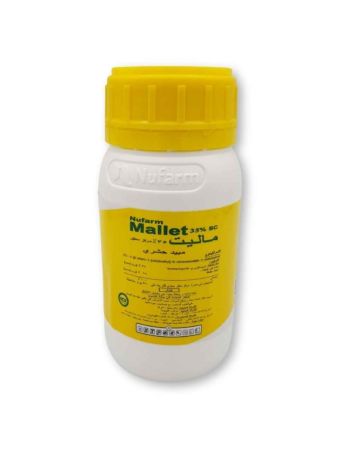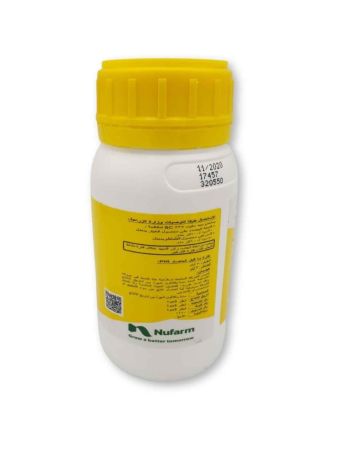Mallet 35% SC 250cm³
- View all variations as list
| CODE | Size | Availability | Price | ||
|---|---|---|---|---|---|

|
636552C43B80A
|
Out of stock
|
Contact us for a price | ||

|
Out of stock
|
Contact us for a price |
Mallet 35% SC, produced by Nufarm Australia, is considered one of the best insecticidal compounds used to control a large range of sucking insects and thus protect crops from infection with viral diseases that these insects cause to transmit and spread infection between different crops such as leaf curl (PLR) and leaf curl (PVY) in potatoes, and cucumber and bean mosaic (CMV) and tomato viral disease (TYLCV) as well as tunnel makers that have severe damage to the crop and thus the final product.
Effective Material:
Mallet is a systemic insecticide belonging to the Neonicotinoid group. It contains the active substance Imidacloprid at 35% SC, which is characterized by its superior and extended efficacy against many piercing-sucking insects.
How It Works:
Mallet is an enteric and contact nervous system pesticide that works to stop the transmission of nerve signals from the nervous system to the different parts of the insect's body.
Features:
- Mallet is a systemic insecticide and it is one of the most effective substances in eliminating sucking piercing insects such as whitefly, aphids, thrips, gasids and leafhoppers, which plays an important role in transmitting disease viruses, especially in cucurbits and tomatoes.
- Mallet is effective against scale insects, waxy fig, mealybugs and tunnel makers.
- Mallet is highly effective against strains that have acquired immunity to other insecticidal compounds.
- Mallet has excellent efficacy in eliminating the insect by stomach and touch.
- Mallet is used as a spray on the leaves or on the soil through irrigation or watering due to its superior ability to penetrate the plant through the vegetative and root system.
- Mallet is most effective at low doses with prolonged effect.
- Mallet is characterized by its low toxicity to humans and farm animals.
- Mallet is compatible with Integrated Management Programs (IPM) as it does not affect vital organs.
Pre-harvest Period:
3 days for cucumbers and tomatoes.
Recommendations and uses for vegetables and field crops:
| Crops | Diseases | Rate of Use |
| Cucumber | Whitefly | Spraying is carried out at a rate of 30 cm³/100 L of water. |
| Tomato | Aphids | Spraying is carried out at a rate of 50 cm³/100 L of water. |
| Tomato - vegetables | Whitefly | - In the case of seedlings: the treatment is carried out by watering the trays at a rate of 2 cm³/tray upon germination, and the treatment is repeated after a week. - In the case of permaculture: after transplanting, spraying is carried out at a rate of 30 cm³/100 L of water, and the treatment is repeated after two weeks. |
| Potato | - Aphids, leafhoppers - Whitefly | - The shoots of the plant are sprayed at a rate of 50 cm³/100 L of water. - The shoots of the plant are sprayed at a rate of 30 cm³/100 L of water. |
| Onion | Thrips | Spraying is carried out at a rate of 50 cm 3 / liter of water, and the spraying is repeated 7-10 days after the first spray. |
| Beans | Beans Aphids | Spraying is carried out at a rate of 50 cm 3 / liter of water, and the spraying is repeated 7-10 days after the first spray. |
| Cotton | Aphids | Spraying is carried out at a rate of 30 cm³/100 L of water. |
Recommendations and uses for fruits gardens and decoration plants:
| Crops | Diseases | Rate of Use |
| Grape | Mealybug | Spraying is carried out after pruning at a rate of 150 cm³/feddan. It is recommended to peel the bark before spraying. |
| Citrus | 1- Leafminers 2- Scale insects 3- Aphids, thrips, mealybugs | 1- The vegetative mass is sprayed at a rate of 75 cm³/100 L of water, provided that the treatment is carried out when the new growths begin to emerge. 2- The shoot is sprayed at a rate of 75 cm³/100 L of water 3- The shoot is sprayed at a rate of 50 cm³/100 L of water |
| Sweet trees (apricot, peach, plum) | 1- Leafminers 2- Aphids | 1- The shoot is sprayed at a rate of 75 cm³/100 L of water 2- The shoot is sprayed at a rate of 50 cm³/100 L of water |
| Palm | Red palm weevil | Watering is carried out around the trunk of the palm after harvesting the crop at a rate of 20-25 cm³ per liter of water/tree, and the treatment is repeated after two months. |
| Decoration Plants | 1- Whitefly 2- Aphids, thrips | 1- Spraying is carried out at a rate of 30 cm³/L of water 2- Spraying is carried out at a rate of 50 cm³/L of water |
- Imidacloprid
No reviews found
-
Fast Delivery
-
Secure Payement
-
Low Prices


